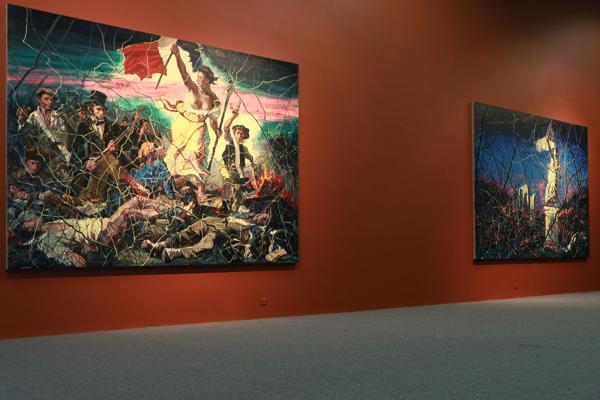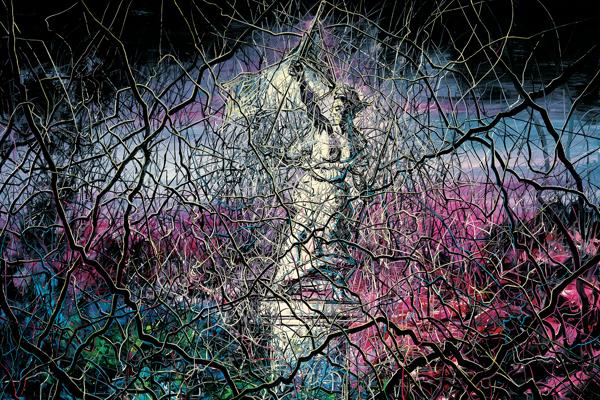
From 1830 Till Now, created by Zeng Fanzhi for a special show at the Louvre in Paris last year, is now on display at ShanghART Beijing. [Photo/Provided to China Daily]
Zeng Fanzhi has created a series of works that link classic European masters with contemporary painting. Lin Qi reports.
Zeng Fanzhi’s solo exhibition at ShanghART Beijing is “a quiet show catering purely to painting lovers”, gallery founder Lorenz Helbling says.
The Louvre Project displays four paintings, From 1830 Till Now, which Zeng, 51, created for a special show at the Louvre in Paris last year. The idea originated at a meeting between Zeng and Henri Loyrette, then director of the Louvre, in Hong Kong in 2011. The two decided to cooperate on an exhibition to examine the interaction between classic and contemporary art.
From Oct 22 to Nov 17, From 1830 Till Now No 4 appeared in the Louvre’s Room 77, which is known for its dark red walls and the masterpieces on show, including Liberty Leading the People by Eugene Delacroix.
Zeng created an encounter between the past and present, the realistic and abstract in his series. He placed Marianne, the Goddess of Liberty from Delacroix’s work, into a scene in his series, Messy Landscape.
The show at ShanghART presents the whole series — No 1, 2, 3 and 4 together — for the first time.

“An artist made repeated attempts to accomplish one theme — it’s undoubtedly a rather interesting topic for an exhibition,” Helbling said ahead of the exhibition’s opening in early March.
The walls at ShanghART Beijing have been painted a dark red, which, according to Helbling, is also a part of the work.
“They echo with the Louvre. Also, they represent Western art in the eyes of Chinese artists and the public. It has been a long-standing concept for most of the people, and how to interpret it may vary utterly in the past, present and future.”
No 1 and No 4 share the same wall to mark the beginning and the end of the project. Visitors can see how Zeng changed and furthered in exploring the motif.
Zeng paid tribute to the masters of classic painting in No 1. He took a traditional approach to the painting, so it is most like the original piece in composition and detail. The remaining three works together depict a process of self-discovery for the artist, which was realized through the changes in appearance of the Goddess of Liberty and the fighters.
Aside from Messy Landscape, Zeng depicted the Goddess of Liberty in three other paintings. But he didn’t enhance the figure. He instead drew her in simple lines.
“Again and again, I covered her with more lines. And finally, I transformed her from flesh into a statue,” he says.

“In the last work, No. 4, I couldn’t help but add some broken walls around her. No humans, no lives — maybe this is what the ultimate freedom should be.”
Zeng once said he first saw Liberty Leading the People in 1985, rendered as a stamp-size image in a history textbook that transfixed him. The figure of the half-naked goddess in the center was quite a shock to conservative Chinese society at that time.
“I pondered why the painting appeals to people so much. Delacroix portrayed the fighters in a realistic manner. He instilled all his imagination in the goddess,” he said in a talk before the Louvre show.
“Seemingly, she doesn’t belong to the normal time and space of the others, but only exists in Delacroix’s subject world of himself. The unreal and the real come across in a dramatic scenario that explodes with strong emotions.”
Zeng studied oil painting at the Hubei Institute of Fine Arts. When he worked on his graduation paintings in 1990, Chinese painters were mainly interested in the realistic-genre painting — a result of the Russian Society of Traveling Art Exhibitions of the 19th century.
Zeng started to paint people at the Xiehe Hospital near his home in Wuhan, the provincial capital. In the Xiehe Hospital Series, which made him famous, Zeng portrayed three scenes of medical staff treating patients. He departed from the realistic approach but injected his feelings into the work. He attributed the inspiration of these paintings to the enlightenment he found in Liberty Leading the People.

“Chinese art has changed violently over the past 20 years. I think Zeng remains quite stable and persistent, compared with many other artists. Invariably, he endeavors in the realm of painting, which is rare and praiseworthy,” Helbling says.
A screen at the exhibition plays a documentary of the Louvre show. Visitors were asked to comment on Zeng’s work. Some were fascinated by his bold treatment. Others didn’t think it fit the room.
At the end of the video, Zeng says the visitors he wishes could see his work the most are the great masters who created the other paintings in the room.
“After the museum closes and the lights are turned off, maybe their souls will leave their works and judge the paintings on show,” he says.
“I wonder how they will critique mine.”

